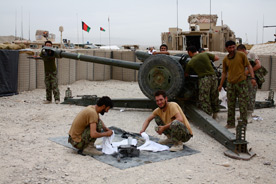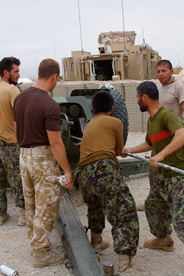Afghanistan’s Artillery Corps comes of age in Helmand
In Afghanistan, advances are often measured in baby steps rather than leaps and bounds. However this month, in the town of Gereshk in Helmand Province, the pitter-patter of progress was exchanged for the booming cacophony of heavy guns, as the Artillery Corps of the Afghan National Army (ANA) 3/215 Brigade was making sure every one knew just how far it had come in its transition from a force in training, to a strong, independently-functioning, Afghan unit.

ANA Artillery soldiers from 3/215 Brigade based at Artillery Hill in Gereshk, Helmand Province fire their big guns in support of an ANA-ANP led operation in the town, in conjunction with ISAF troops.
Around a dozen ANA soldiers in charge of the Howitzers on top of the aptly-named Artillery Hill have spent the past months gleaning all the knowledge they can from a group of international mentors. Australians, British, Danes and Americans all share the camp with them, which overlooks the Helmand River in Gereshk. The camp not only enjoys astoundingly beautiful views across the valley, but also a strategic position above a town still riddled with insurgents, which the Afghan National Security Forces (ANSF) and ISAF troops are determined to dominate.

Until now the Afghan soldiers’ days have been spent taking care of their prized weapons. Occasionally they have been called upon to fire allume shells in support of Afghan and ISAF operations on the ground, lighting up the surrounding countryside to deny the insurgents their hiding places.
However, this month the time has come for these troops to put all their skills to the true test of live fire. As the exercise got underway, the excitement among them was palpable.
“This is massive for them,” explains Major Mike Lynskey, a British officer with the Irish Guards Regiment, which has been working with the 3/215 Brigade for the past six months as part of the 3 Para Brigade Advisory Group. “It is a confirmation of all they have learned, and a chance for them to show off all their skills and drills,” he says.
With the ammunition costing £500 (€650/US$750) a shell, and thousands of people living on the plain below, there was no room for error.
The big guns themselves are half a century old, and though lovingly maintained they have their foibles. At one point during the live fire exercise one of the weapons jammed and an Afghan soldier came running over with a mallet to fix it. Whatever he did worked and the exercise could resume. But the gun crew was careful to retreat behind a wall of Hesco blast barrier before firing it again using a length of rope.
“These are still early days,” said Sergeant Paul Challoner, a British advisor from the Royal Horse Artillery, but he was obviously pleased with the progress on display. “We are still ironing some things out,” he tells us.

When the Afghans’ ammunition supply is depleted – all of it landing on target and without any mishap – the Danish troops take the opportunity to display their mortar skills.
The push to augment the numbers of the ANSF is in full swing. Thousands of new recruits are participating in training courses and there are graduation ceremonies taking place across Afghanistan for the police and army almost every week. While the emphasis is on training enough people for the Afghan government to enjoy a significant show of strength, they will have to take over all the roles presently being filled by ISAF soldiers. This means the ANA especially needs as many experts as foot soldiers. So, after basic training, Afghan warriors have the opportunity to specialise in areas such as combat engineering, bomb disposal, logistics, field medical procedures and the artillery.
The international mentors on Artillery Hill insist this is a work in progress that will eventually pave the way for all ISAF troops to leave Afghanistan, although with people like themselves probably being the last to go. Australian Lieutenant Colonel Kane Mangin says, “I reckon it will take between four and ten years before the Afghans will be able to do it totally on their own” .
There is no doubt the Afghans are looking forward to that day.
“In a couple of years we will take over,” says ANA Sergeant Ishmael Ali Khan, the Afghan Battery Commander. “What we are doing here is essential because we are definitely going to need artillery on the ground to keep the peace,” he explains.
